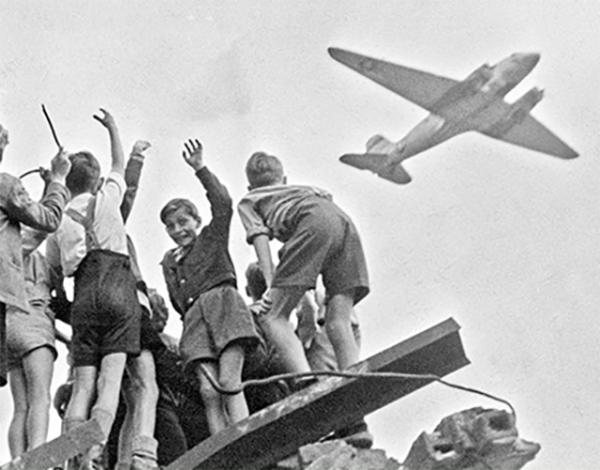KID REPORTERS’ NOTEBOOK
“The Candy Bomber”


German children stand atop a ruined building in the western section of Berlin in 1948, cheering as a U.S. cargo plane arrives with food, fuel, and other supplies. Many children also got candy.
When World War II ended in 1945, much of Europe was in ruins. The conflict, which began when German dictator Adolf Hitler invaded Poland in 1939, had claimed millions of lives and destroyed cities and towns. After the United States and its allies defeated Germany, the allies divided the war-torn country and its capital, Berlin, into occupation zones (see map).
But in 1948, the Soviet Union, led by dictator Joseph Stalin, wanted more control in the region. The Soviets blocked rail and road access to the western section of Berlin, leaving more than 2 million Germans without food, fuel, and other necessities.
“I’ll WIGGLE MY WINGS”
Gail Halvorsen, then a 28-year-old U.S. Air Force pilot, was assigned to help deliver supplies in what became known as the “Berlin Airlift.” While visiting an airport one afternoon, Halvorsen saw a group of German children watching the planes land. “Don’t worry about us,” they said through a barbed-wire fence. “Someday, we’ll have enough to eat. But if we lose our freedom, we may never get it back.”
Halvorsen was so moved by the children’s words that he decided to act. “It was their spirit of gratitude that made all the difference,” he said in a recent interview in Orem, Utah. “I told the kids to come back to the fence the next day, and I would drop candy from my airplane.” When one of the kids asked how they would know which plane was his, Halvorsen said, “I’ll wiggle my wings.”
The decision to deliver candy was a courageous one. Halvorsen did not have permission to deliver extra supplies. “I was a very honest man in the Air Force,” he said. “But the thing that made me change was a good thing.”
Halvorsen crafted tiny parachutes from handkerchiefs and string, attaching chocolates and other candies to the string. When his efforts gained support from the Air Force, U.S. candy companies donated to the cause. During a span of 14 months, Haloversen and other U.S. pilots dropped more than 20 tons of candy for Berlin’s children, leading one child to say, “It wasn’t [just] chocolate. It was hope.”

German children stand atop a ruined building in the western section of Berlin in 1948, cheering as a U.S. cargo plane arrives with food, fuel, and other supplies. Many children also got candy.
“ENEMIES BECOME FRIENDS”
Halvorsen still meets people who remember his flights. One woman, he said, “caught several of my parachutes, and because no fabric was available, she sewed them into underwear. She had the nicest underwear of anyone around!”
Halvorsen is known throughout the world as “the Chocolate Flier,” “Uncle Wiggly Wings,” and, most commonly, “the Candy Bomber.” At 94, he still delights crowds by dropping delicious gifts from the sky. His experience during the Berlin Airlift, he says, shows the importance of helping others and being thankful.
“The children were so grateful,” Halvorsen said. “If they had grabbed my arm and said, ‘Give me something,’ this never would have happened. Gratitude helps enemies become friends.”
